
Red Barn Murder
Encyclopedia
- Murder in the Red Barn redirects here. For the 1935 film, see Maria Marten, or The Murder in the Red Barn.
- Maria Marten redirects here. For films and plays of the same name Maria Marten (disambiguation)Maria Marten (disambiguation)Maria Marten was a murder victim in Suffolk, England.Maria Marten may also refer to:* Maria Marten , a silent British film directed by Maurice Elvey* Maria Marten , a silent British film directed by Walter West...
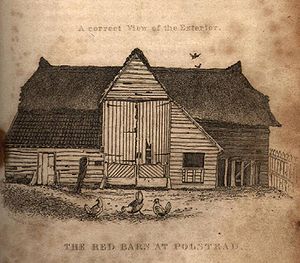
Polstead
Polstead is a small village and civil parish in the South of Suffolk, England.- History :It is noted for being the site of the Red Barn Murder in 1827...
, Suffolk
Suffolk
Suffolk is a non-metropolitan county of historic origin in East Anglia, England. It has borders with Norfolk to the north, Cambridgeshire to the west and Essex to the south. The North Sea lies to the east...
, England
England
England is a country that is part of the United Kingdom. It shares land borders with Scotland to the north and Wales to the west; the Irish Sea is to the north west, the Celtic Sea to the south west, with the North Sea to the east and the English Channel to the south separating it from continental...
, in 1827. A young woman, Maria Marten, was shot dead by her lover, William Corder. The two had arranged to meet at the Red Barn, a local landmark, before eloping to Ipswich
Ipswich
Ipswich is a large town and a non-metropolitan district. It is the county town of Suffolk, England. Ipswich is located on the estuary of the River Orwell...
. Maria was never heard from again. Corder fled the scene and although he sent Marten's family letters claiming she was in good health, her body was later discovered buried in the barn after her stepmother spoke of having dreamt about the murder.
Corder was tracked down in London, where he had married and started a new life. He was brought back to Suffolk, and after a well-publicised trial, found guilty of murder. He was hanged
Hanging
Hanging is the lethal suspension of a person by a ligature. The Oxford English Dictionary states that hanging in this sense is "specifically to put to death by suspension by the neck", though it formerly also referred to crucifixion and death by impalement in which the body would remain...
in Bury St Edmunds in 1828; a huge crowd witnessed Corder's execution. The story provoked numerous articles in the newspapers, and songs and plays. The village where the crime had taken place became a tourist attraction and the barn was stripped by souvenir hunters. The plays and ballads remained popular throughout the next century and continue to be performed today.
Murder
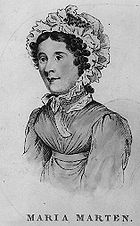
Molecatcher
Molecatching is the process of trapping or killing moles in places, notably farms and gardens, where they are considered a threat to crops, yards or gardens.- History of molecatching :...
from Polstead
Polstead
Polstead is a small village and civil parish in the South of Suffolk, England.- History :It is noted for being the site of the Red Barn Murder in 1827...
, Suffolk.
In March 1826, when she was 24, she formed a relationship with the 22-year-old William Corder (born 1803). Marten was an attractive woman and relationships with men from the neighbourhood had already resulted in two children. One, the child of William's older brother Thomas, died as an infant, but the other, Thomas Henry, was still alive at the time Marten met Corder. Although Thomas Henry's father wanted nothing more to do with Marten after the birth, he occasionally sent money to provide for the child.
William Corder was the son of a local farmer, and had a reputation as something of a fraudster and a ladies' man. He was known as "Foxey" at school because of his sly manner. He had fraudulently sold his father's pigs, and, although his father had settled the matter without involving the law, Corder had not changed his behaviour. He later obtained money by passing a forged cheque
Cheque
A cheque is a document/instrument See the negotiable cow—itself a fictional story—for discussions of cheques written on unusual surfaces. that orders a payment of money from a bank account...
for £93 (£ as of ), and he had helped a local thief, Samuel "Beauty" Smith, steal a pig from a neighbouring village. When Smith was questioned by the local constable over the theft, he made a prophetic statement concerning Corder: "I'll be damned if he will not be hung some of these days". Corder had been sent to London in disgrace after his fraudulent sale of the pigs, but he was recalled to Polstead when his brother Thomas drowned attempting to cross a frozen pond. His father and three brothers all died within 18 months of each other and only William remained to run the farm with his mother.
Although Corder wished to keep his relationship with Marten secret, she gave birth to their child in 1827, at the age of 25, and was apparently keen that she and Corder should marry. The child died (later reports suggested that it may have been murdered), but Corder apparently still intended to marry Marten. That summer, in the presence of her stepmother, Ann Marten, he suggested that she meet him at the Red Barn, from where he proposed that they elope to Ipswich. Corder claimed that he had heard rumours that the parish officers were going to prosecute Maria for having bastard
Bastard (Law of England and Wales)
A bastard in the law of England and Wales is a person whose parents, at the time of his/her birth, were not married to each other....
children. He initially suggested they elope on the Wednesday evening, but later decided to delay until the Thursday evening. On Thursday he was again delayed: his brother falling ill is mentioned as the reason in some sources, although most claim all his brothers were dead by this time. The next day, Friday, 18 May 1827, he appeared at the Martens' cottage during the day, and according to Ann Marten, told Maria that they must leave at once, as he had heard that the local constable had obtained a warrant to prosecute her (no warrant had been obtained, but it is not known if Corder was lying or was mistaken). Maria was worried that she could not leave in broad daylight, but Corder told her she should dress in men's clothing so as to avert suspicion, and he would carry her things to the barn where she could meet him and change before they continued on to Ipswich.

Great Yarmouth
Great Yarmouth, often known to locals as Yarmouth, is a coastal town in Norfolk, England. It is at the mouth of the River Yare, east of Norwich.It has been a seaside resort since 1760, and is the gateway from the Norfolk Broads to the sea...
, or some other place nearby, and that he could not yet bring her back as his wife for fear of provoking the anger of his friends and relatives. The pressure on Corder to produce his wife eventually forced him to leave the area. He wrote letters to Marten's family claiming they were married and living on the Isle of Wight
Isle of Wight
The Isle of Wight is a county and the largest island of England, located in the English Channel, on average about 2–4 miles off the south coast of the county of Hampshire, separated from the mainland by a strait called the Solent...
, and gave various excuses for her lack of communication: she was unwell, had hurt her hand, or that the letter must have been lost.
Suspicion continued to grow, and Maria's stepmother began talking of dreams that Maria had been murdered and buried in the Red Barn. On 19 April 1828 she persuaded her husband to go to the Red Barn and dig in one of the grain storage bins. He quickly uncovered the remains of his daughter buried in a sack. She was badly decomposed but still identifiable. An inquest
Inquest
Inquests in England and Wales are held into sudden and unexplained deaths and also into the circumstances of discovery of a certain class of valuable artefacts known as "treasure trove"...
was carried out at the Cock Inn (which still stands today) at Polstead, where Maria was formally identified, by her sister Ann, from some physical characteristics: her hair and some clothing were recognizable and a tooth she was known to be missing was also missing from the jawbone of the corpse. Evidence was uncovered to implicate Corder in the crime: his green handkerchief was discovered around the body's neck.
Capture
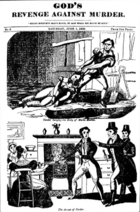
Metropolitan Police Service
The Metropolitan Police Service is the territorial police force responsible for Greater London, excluding the "square mile" of the City of London which is the responsibility of the City of London Police...
force who would later lead the investigation into Spring Heeled Jack
Spring Heeled Jack
Spring-heeled Jack is a character in English folklore of the Victorian era who was known for his startling jumps. The first claimed sighting of Spring-heeled Jack was in 1837. Later sightings were reported all over England and were especially prevalent in suburban London, the Midlands and...
, he tracked Corder to a ladies' boarding house, Everley Grove House, in Brentford
Brentford
Brentford is a suburban town in west London, England, and part of the London Borough of Hounslow. It is located at the confluence of the River Thames and the River Brent, west-southwest of Charing Cross. Its former ceremonial county was Middlesex.-Toponymy:...
. Corder was running the boarding house with his new wife, Mary Moore, whom he had met through a newspaper advertisement that he had placed in The Times
The Times
The Times is a British daily national newspaper, first published in London in 1785 under the title The Daily Universal Register . The Times and its sister paper The Sunday Times are published by Times Newspapers Limited, a subsidiary since 1981 of News International...
(which had received more than 100 replies). Lea managed to gain entry under the pretext that he wished to board his daughter there, and surprised Corder in the parlour. Thomas Hardy
Thomas Hardy
Thomas Hardy, OM was an English novelist and poet. While his works typically belong to the Naturalism movement, several poems display elements of the previous Romantic and Enlightenment periods of literature, such as his fascination with the supernatural.While he regarded himself primarily as a...
noted the Dorset County Chronicles report of his capture:
Lea took him to one side and informed him of the charges; Corder denied all knowledge of both Maria and the crime. A search of the house uncovered a pair of pistols supposedly bought on the day of the murder; some letters from a Mr. Gardener, which may have contained warnings about the discovery of the crime; and a passport
Passport
A passport is a document, issued by a national government, which certifies, for the purpose of international travel, the identity and nationality of its holder. The elements of identity are name, date of birth, sex, and place of birth....
from the French Ambassador, evidence which suggested Corder may have been preparing to flee.
Trial
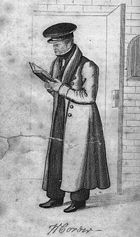
County Hall
A county hall or shire hall is usual name given to a building housing a county's administration. The location of the county hall has usually denoted the county town, and as county halls have moved it has also been considered that the county town has moved, for example when Derbyshire County Council...
, Bury St. Edmunds. The trial started on 7 August 1828, having been put back several days because of the interest the case had generated. The hotels in Bury St. Edmunds began to fill up from as early as 21 July and, because of the large numbers that wanted to view the trial, admittance to the court was by ticket only. Despite this the judge and court officials still had to push their way bodily through the crowds that had gathered around the door to gain entry to the court room.
The judge, Chief Baron Alexander, was unhappy with the coverage given to the case by the press "to the manifest detriment of the prisoner at the bar".
The Times, nevertheless, congratulated the public for showing good sense in aligning themselves against Corder.
Corder entered a plea of not guilty. The exact cause of death could not be established. It was thought that a sharp instrument, possibly Corder's short sword, had been plunged into Marten's eye socket, but this wound could also have been caused by her father's spade when he was exhuming the body. Strangulation
Strangling
Strangling is compression of the neck that may lead to unconsciousness or death by causing an increasingly hypoxic state in the brain. Fatal strangling typically occurs in cases of violence, accidents, and as the auxiliary lethal mechanism in hangings in the event the neck does not break...
could not be ruled out as Corder's handkerchief had been discovered around her neck, and, to add to the confusion, the wounds to her body suggested she had been shot. The indictment charged Corder with "…murdering Maria Marten, by feloniously and wilfully shooting her with a pistol through the body, and likewise stabbing her with a dagger." To avoid any chance of a mistrial, he was indicted on nine charges, including one of forgery
Forgery
Forgery is the process of making, adapting, or imitating objects, statistics, or documents with the intent to deceive. Copies, studio replicas, and reproductions are not considered forgeries, though they may later become forgeries through knowing and willful misrepresentations. Forging money or...
.
Ann Marten was called to give evidence of the events of the day of Maria's disappearance and her later dreams. Thomas Marten then told the court how he had dug up his daughter, and George Marten, Maria's 10-year-old brother, revealed that he had seen Corder with a loaded pistol before the alleged murder and later had seen him walking from the barn with a pickaxe. Lea gave evidence concerning Corder's arrest and the objects found during the search of his house. The prosecution suggested that Corder had never wanted to marry Maria, but that her knowledge of some of his criminal dealings had given her a hold over him, and that his theft previously of the money sent by her child's father had been a source of tension between them.
Corder then gave his own version of the events. He admitted to being in the barn with Maria but said he had left after they argued. He claimed that while he was walking away he heard a pistol shot and running back to the barn found Maria dead with one of his pistols beside her. He pleaded with the jury to give him the benefit of the doubt, but after they retired it took them only 35 minutes to return with a guilty verdict. Baron Alexander sentenced him to hang and afterwards be dissected
Dissection
Dissection is usually the process of disassembling and observing something to determine its internal structure and as an aid to discerning the functions and relationships of its components....
:
Corder spent the next three days in prison agonising over whether to confess to the crime and make a clean breast of his sins before God. After several meetings with the prison chaplain
Chaplain
Traditionally, a chaplain is a minister in a specialized setting such as a priest, pastor, rabbi, or imam or lay representative of a religion attached to a secular institution such as a hospital, prison, military unit, police department, university, or private chapel...
, entreaties from his wife, and pleas from both his warder and John Orridge, the governor of the prison, he finally confessed. He strongly denied stabbing Maria, claiming instead he had accidentally shot her in the eye after they argued while she was changing out of her disguise.
Execution and dissection
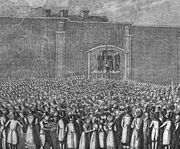
Gallows
A gallows is a frame, typically wooden, used for execution by hanging, or by means to torture before execution, as was used when being hanged, drawn and quartered...
in Bury St. Edmunds, apparently too weak to stand without support.
He was hanged shortly before noon in front of a huge crowd; one newspaper claimed there were 7,000 spectators, another as many as 20,000. At the prompting of the prison governor, just before the hood was drawn over his head he weakly asserted:
After an hour his body was cut down by John Foxton
John Foxton
John Foxton was an English hangman of the early 19th century, a position he held for forty years....
, the hangman, who, according to his rights, claimed Corder's trousers and stockings. The body was taken back to the courtroom at Shire Hall where it was slit open along the abdomen to expose the muscles. The crowds were allowed to file past until six o'clock when the doors were shut. According to the Norwich and Bury Post, over 5,000 people queued to see the body.
The following day the dissection and post-mortem were carried out in front of an audience of students from Cambridge University and physicians. A battery was attached to Corder's limbs to demonstrate the contraction of the muscles, the sternum was opened and the internal organs examined. There was some discussion as to whether the cause of death was suffocation
Asphyxia
Asphyxia or asphyxiation is a condition of severely deficient supply of oxygen to the body that arises from being unable to breathe normally. An example of asphyxia is choking. Asphyxia causes generalized hypoxia, which primarily affects the tissues and organs...
, but since it was reported that Corder's chest was seen to rise and fall for several minutes after he had dropped, it was thought probable that pressure on the spinal cord
Spinal cord
The spinal cord is a long, thin, tubular bundle of nervous tissue and support cells that extends from the brain . The brain and spinal cord together make up the central nervous system...
had killed him. Since the skeleton was to be reassembled after the dissection, it was not possible to examine the brain, so instead the surgeons contented themselves with a phrenological
Phrenology
Phrenology is a pseudoscience primarily focused on measurements of the human skull, based on the concept that the brain is the organ of the mind, and that certain brain areas have localized, specific functions or modules...
examination of the skull
Human skull
The human skull is a bony structure, skeleton, that is in the human head and which supports the structures of the face and forms a cavity for the brain.In humans, the adult skull is normally made up of 22 bones...
. Corder's skull was asserted to be profoundly developed in the areas of "secretiveness, acquisitiveness, destructiveness, philoprogenitiveness, and imitativeness" with little evidence of "benevolence or veneration". The bust of Corder held by Moyse's Hall Museum in Bury St. Edmunds is an original made by Child of Bungay, Suffolk
Bungay, Suffolk
Bungay is a market town in the English county of Suffolk. It lies in the Waveney valley, west of Beccles on the edge of The Broads, and at the neck of a meander of the River Waveney.-Early history:...
, as a tool for the study of Corder's phrenology. The skeleton was reassembled, exhibited and used as a teaching aid in the West Suffolk Hospital. Several copies of his death mask
Death mask
In Western cultures a death mask is a wax or plaster cast made of a person’s face following death. Death masks may be mementos of the dead, or be used for creation of portraits...
were made, a replica of one is held at Moyse's Hall Museum. Artifacts from the trial and some which were in Corder's possession are also held at the museum. Corder's skin was tanned
Tanning
Tanning is the making of leather from the skins of animals which does not easily decompose. Traditionally, tanning used tannin, an acidic chemical compound from which the tanning process draws its name . Coloring may occur during tanning...
by the surgeon George Creed, and used to bind an account of the murder
Anthropodermic bibliopegy
Anthropodermic bibliopegy is the practice of binding books in human skin. Though extremely uncommon in modern times, the technique dates back to at least the 17th century...
.
Corder's skeleton was put on display in the Hunterian Museum in the Royal College of Surgeons of England
Royal College of Surgeons of England
The Royal College of Surgeons of England is an independent professional body and registered charity committed to promoting and advancing the highest standards of surgical care for patients, regulating surgery, including dentistry, in England and Wales...
, where it hung beside that of Jonathan Wild
Jonathan Wild
Jonathan Wild was perhaps the most infamous criminal of London — and possibly Great Britain — during the 18th century, both because of his own actions and the uses novelists, playwrights, and political satirists made of them...
. In 2004, Corder's bones were removed from display and cremated.
Rumours
After the trial, doubts were raised about both the story of the stepmother's dreams and the fate of Maria and William's child. The stepmother was only a year older than Maria, and it was suggested that she and Corder had been having an affair, and the two had planned the murder to dispose of Maria so that it could continue without hindrance. Since her dreams had started only a few days after Corder married Moore, it was suggested that jealousy was the motive for revealing the body's resting place and that the dreams were a simple subterfuge.Further rumours circulated about the death of Corder and Marten's child. Both claimed that they had taken their dead child to be buried in Sudbury
Sudbury, Suffolk
Sudbury is a small, ancient market town in the county of Suffolk, England, on the River Stour, from Colchester and from London.-Early history:...
, but no records of this could be discovered and no trace of the burial site of the child was ever found. In his written confession Corder admitted that on the day of the murder he and Marten had argued over the possibility of the burial site being discovered.
In the 20th Century a new set of rumours appeared when the writer and researcher Donald McCormick
Donald McCormick
George Donald King McCormick was a British journalist and popular historian, who also wrote under the pseudonyms Richard Deacon and Lichade Digen....
wrote The Red Barn Mystery. He brought out some interesting points, including a hitherto unknown connection between Corder and the forger and poisoner Thomas Griffiths Wainewright
Thomas Griffiths Wainewright
Thomas Griffiths Wainewright was an English artist, writer and criminal, widely believed to have been a multiple poisoner.-Early life:...
when Corder was in London, and that an actress Caroline Palmer, who was appearing frequently in the melodrama based on the case and researching the murder, concluded that Corder may have not killed Maria and that a local gypsy woman might have been the killer. However, McCormick's research on other police related and crime related stories has been brought into question and this information has not been generally accepted.
Popular interest
The case had all the elements to ignite a fervent popular interest: the wicked squire and the poor girl, the iconic murder scene, the supernatural element of the stepmother's prophetic dreams, the detective work by Ayres and Lea (who later became the detective Pharos Lee in stage versions of the events) and Corder's new life which was the result of a lonely hearts advertisement. As a consequence, the case created its own small industry.
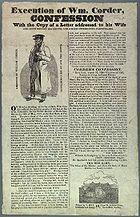
Newgate novel
The Newgate novels were novels published in England from the late 1820s until the 1840s that were thought to glamorise the lives of the criminals they portrayed...
s—which quickly became a best-seller. Along with the story of Jack Sheppard
Jack Sheppard
Jack Sheppard was a notorious English robber, burglar and thief of early 18th-century London. Born into a poor family, he was apprenticed as a carpenter but took to theft and burglary in 1723, with little more than a year of his training to complete...
and other highwaymen, thieves and murderers, the Red Barn Murder was a popular subject for penny gaff
Penny gaff
A penny gaff was a popular entertainment for the lower classes in 19th century England. It consisted of short, theatrical entertainments which could be staged wherever space permitted, such as the back room of a public house or small hall. Unsophisticated, the props and scenery rarely consisted of...
s, cheap plays performed for the entertainment of the lower classes in the gin-soaked atmosphere of the back rooms of public houses. After the execution, James Catnach managed to sell over a million broadsides
Street literature
Street literature or broadsides began in the 16th century and continued until the mid-19th century as a type of printing of large printed sheets of paper, designed to be plastered onto walls...
(sensationalist single sheet newspapers). Catnach's sheets gave details of Corder's confession and the execution, and included a sentimental ballad supposedly penned by Corder himself, but more likely to have been the work of Catnach or somebody in his employ. It was one of at least five ballads about the crime that appeared directly following the execution.
Owing to the excitement around the trial and the public demand for entertainments based on the murder, many different versions of the events were set down and distributed, making it hard for modern readers to discern fact from melodramatic embellishment. Good records of the trial exist from the official records, and the best record of the events surrounding the case is generally considered to be that of James Curtis
James Curtis (journalist)
James Curtis was a British journalist and eccentric. He is best known for his association with William Corder, hanged for the Red Barn Murder....
, a journalist who spent time with Corder and two weeks in Polstead interviewing those concerned. Curtis was apparently so connected with the case that when asked to produce a picture of the accused man, an artist for one of the newspapers drew him rather than Corder.
Pieces of the rope which was used to hang Corder sold for a guinea
Guinea (British coin)
The guinea is a coin that was minted in the Kingdom of England and later in the Kingdom of Great Britain and the United Kingdom between 1663 and 1813...
each. Part of Corder's scalp with an ear still attached was displayed in a shop in Oxford Street. A lock of Maria's hair sold for two guineas. Polstead became a tourist venue with visitors travelling from as far afield as Ireland; Curtis estimated that 200,000 people visited Polstead in 1828 alone. The Red Barn and the Martens' cottage excited particular interest. The barn was stripped for souvenirs, down to the planks being removed from the sides, broken up and sold as toothpicks. It was planned to be demolished after the trial, but it was left standing and eventually burnt down in 1842. Even Maria's gravestone was eventually chipped away to nothing by souvenir hunters. Pottery models and sketches were sold and songs composed, including one mentioned in the Vaughan Williams
Ralph Vaughan Williams
Ralph Vaughan Williams OM was an English composer of symphonies, chamber music, opera, choral music, and film scores. He was also a collector of English folk music and song: this activity both influenced his editorial approach to the English Hymnal, beginning in 1904, in which he included many...
opera
Opera
Opera is an art form in which singers and musicians perform a dramatic work combining text and musical score, usually in a theatrical setting. Opera incorporates many of the elements of spoken theatre, such as acting, scenery, and costumes and sometimes includes dance...
Hugh the Drover
Hugh the Drover
Hugh the Drover is an opera in two acts by Ralph Vaughan Williams to an original English libretto by Harold Child. According to Michael Kennedy, the composer took first inspiration for the opera from this question to Bruce Richmond, editor of The Times Literary Supplement, around 1909–1910:"I...
.
Corder's skeleton was put on display in a glass case in the West Suffolk Hospital, and apparently rigged with a mechanism that made its arm point to the collection box when approached. Eventually, the skull was replaced by a Dr. Kilner who wanted to add Corder's skull to his extensive collection of Red Barn memorabilia. After a series of unfortunate events, Kilner became convinced the skull was cursed and handed it on to his friend Hopkins. Further disasters plagued both men and they finally paid for the skull to be given a Christian burial in an attempt to lift the supposed curse.
Interest in the case did not quickly fade. Maria Marten; or The Murder in the Red Barn, which existed in various anonymous versions, was a sensational hit throughout the mid 19th century and may have been the most performed play of this time; Victorian fairground peepshow
Peep show
A peep show or peepshow is an exhibition of pictures, objects or people viewed through a small hole or magnifying glass. Though historically a peep show was a form of entertainment provided by wandering showmen, nowadays it more commonly refers a presentation of a sex show or pornographic film...
s were forced to add extra apertures to their viewers when exhibiting their shows of the murder to cope with the demand. The plays of the Victorian era tended to portray Corder as a cold-blooded monster and Maria as the innocent he preyed upon; her reputation and her children by other fathers were airbrushed out, and Corder was made into an older man. Charles Dickens
Charles Dickens
Charles John Huffam Dickens was an English novelist, generally considered the greatest of the Victorian period. Dickens enjoyed a wider popularity and fame than had any previous author during his lifetime, and he remains popular, having been responsible for some of English literature's most iconic...
published an account of the murder in his magazine All The Year Round
All the Year Round
All the Year Round was a Victorian periodical, being a British weekly literary magazine founded and owned by Charles Dickens, published between 1859 and 1895 throughout the United Kingdom. Edited by Dickens, it was the direct successor to his previous publication Household Words, abandoned due to...
after initially rejecting it because he felt the story to be too well known and the account of the stepmother's dreams rather far-fetched.
Although diminished, the fascination continued into the 20th century with five film versions, including the 1935 Maria Marten or Murder in the Red Barn
Maria Marten or Murder in the Red Barn
Maria Marten, or The Murder in the Red Barn is a 1935 British film melodrama film starring Tod Slaughter and Eric Portman. It was directed by Milton Rosmer, whose most famous film was the English-language version of Emil and the Detectives that same year. It is based on the true story of the 1827...
, starring Tod Slaughter
Tod Slaughter
Tod Slaughter was an English actor, best known for playing over-the-top maniacs in macabre film adaptations of Victorian melodramas.-Ealy life:...
, which was only released in the US after some scenes were cut, and a 1980 BBC drama, Maria Marten, with Pippa Guard
Pippa Guard
Philippa Ann Guard is a British actress.Guard was born in Edinburgh, Scotland and belongs to a well-known theatrical family, whose members include her uncle Philip Guard, cousins Christopher Guard and Dominic Guard, and younger brother Alex Guard. Her father was an engineer who moved the family to...
in the title role. A fictionalized account of the murder was produced in 1953 for the CBS radio series "Crime Classics". The incident has inspired a number of contemporary musicians: No Roses
No Roses
No Roses is an album by Shirley Collins and the Albion Country Band. It was recorded at Sound Techniques, and Air Studios in London, in the summer of 1971. It was produced by Sandy Roberton and Ashley Hutchings...
by the Albion Country Band
Albion Country Band
The Albion Band, also known as The Albion Country Band and The Albion Dance Band, were an English electric folk band, brought together and led by musician Ashley Hutchings...
, released in 1971, included the traditional song "Murder of Maria Martin"; more recently, "Murder in the Red Barn", a song by Tom Waits
Tom Waits
Thomas Alan "Tom" Waits is an American singer-songwriter, composer, and actor. Waits has a distinctive voice, described by critic Daniel Durchholz as sounding "like it was soaked in a vat of bourbon, left hanging in the smokehouse for a few months, and then taken outside and run over with a car."...
(co-written with his wife Kathleen Brennan
Kathleen Brennan
Kathleen Brennan is an American musician, songwriter, record producer and artist. She was born in Johnsburg, Illinois, as noted by her husband and musical collaborator Tom Waits, in the song of the same name. Brennan and Waits met in 1980 during the filming of the Francis Ford Coppola film One from...
) from his 1992 album Bone Machine
Bone Machine
Bone Machine is a critically acclaimed and award-winning album by Tom Waits, released in 1992 on Island Records. It won a Grammy Award for Best Alternative Music Album, and features guest appearances by Los Lobos' David Hidalgo, Primus' Les Claypool, and The Rolling Stones' Keith Richards.Bone...
, and Kathryn Roberts and Sean Lakeman
Kathryn Roberts
Kathryn Roberts is an English folk singer, from Barnsley, South Yorkshire.Her first released recordings were on the album Intuition, a collection of songs by various South Yorkshire folk artists which also included her friend Kate Rusby...
's "The Red Barn" on the 2004 album 2 have referred to the event. The song "Maria Martin" included on the folk album White Swans Black Ravens was recorded live in Moyse's Hall Museum. In 1991, a melodramatic stage version, with some political and folk-tale elements, was written by Christopher Bond
Christopher Bond
Christopher Godfrey Bond is a British playwright whose 1973retelling of the Victorian tale Sweeney Todd formed the basis of Stephen Sondheim's musical of the same name, with book by Hugh Wheeler...
, whose first melodrama, Sweeney Todd, inspired Stephen Sondheim to write his musical version
Sweeney Todd: The Demon Barber Of Fleet Street
Sweeney Todd: The Demon Barber of Fleet Street is a 1936 British film produced and directed by George King.-Plot:The film features Tod Slaughter in one of his most famous roles as barber Sweeney Todd. Sweeney Todd was wrongly sentenced to life in prison. After his release 15 years later, he begins...
.

